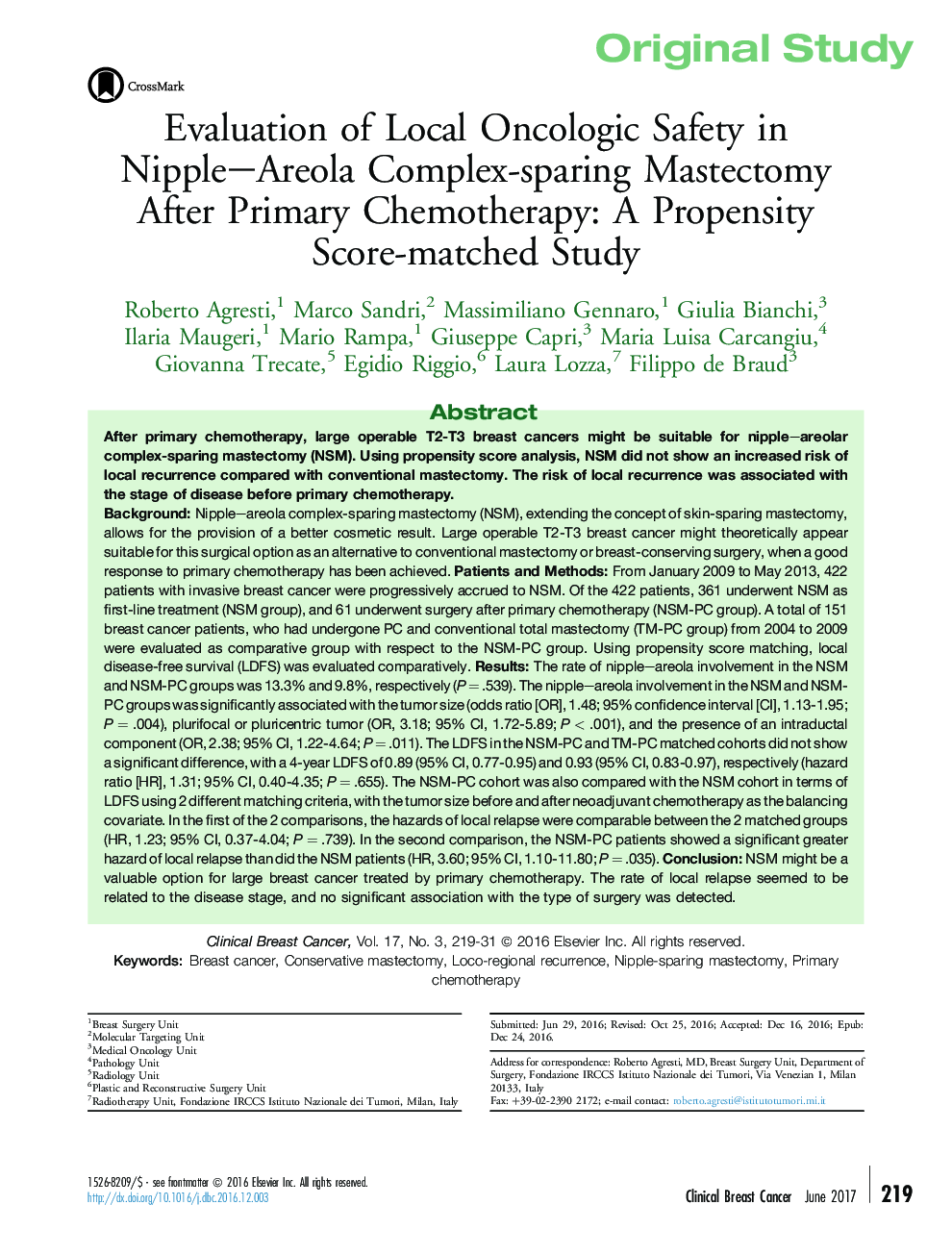| کد مقاله | کد نشریه | سال انتشار | مقاله انگلیسی | نسخه تمام متن |
|---|---|---|---|---|
| 5580661 | 1404178 | 2017 | 13 صفحه PDF | دانلود رایگان |
BackgroundNipple-areola complex-sparing mastectomy (NSM), extending the concept of skin-sparing mastectomy, allows for the provision of a better cosmetic result. Large operable T2-T3 breast cancer might theoretically appear suitable for this surgical option as an alternative to conventional mastectomy or breast-conserving surgery, when a good response to primary chemotherapy has been achieved.Patients and MethodsFrom January 2009 to May 2013, 422 patients with invasive breast cancer were progressively accrued to NSM. Of the 422 patients, 361 underwent NSM as first-line treatment (NSM group), and 61 underwent surgery after primary chemotherapy (NSM-PC group). A total of 151 breast cancer patients, who had undergone PC and conventional total mastectomy (TM-PC group) from 2004 to 2009 were evaluated as comparative group with respect to the NSM-PC group. Using propensity score matching, local disease-free survival (LDFS) was evaluated comparatively.ResultsThe rate of nipple-areola involvement in the NSM and NSM-PC groups was 13.3% and 9.8%, respectively (PÂ = .539). The nipple-areola involvement in the NSM and NSM-PC groups was significantly associated with the tumor size (odds ratio [OR], 1.48; 95% confidence interval [CI], 1.13-1.95; PÂ = .004), plurifocal or pluricentric tumor (OR, 3.18; 95% CI, 1.72-5.89; PÂ <Â .001), and the presence of an intraductal component (OR, 2.38; 95% CI, 1.22-4.64; PÂ = .011). The LDFS in the NSM-PC and TM-PC matched cohorts did not show a significant difference, with a 4-year LDFS of 0.89 (95% CI, 0.77-0.95) and 0.93 (95% CI, 0.83-0.97), respectively (hazard ratio [HR], 1.31; 95% CI, 0.40-4.35; PÂ = .655). The NSM-PC cohort was also compared with the NSM cohort in terms of LDFS using 2 different matching criteria, with the tumor size before and after neoadjuvant chemotherapy as the balancing covariate. In the first of the 2 comparisons, the hazards of local relapse were comparable between the 2 matched groups (HR, 1.23; 95% CI, 0.37-4.04; PÂ = .739). In the second comparison, the NSM-PC patients showed a significant greater hazard of local relapse than did the NSM patients (HR, 3.60; 95% CI, 1.10-11.80; PÂ = .035).ConclusionNSM might be a valuable option for large breast cancer treated by primary chemotherapy. The rate of local relapse seemed to be related to the disease stage, and no significant association with the type of surgery was detected.
Journal: Clinical Breast Cancer - Volume 17, Issue 3, June 2017, Pages 219-231
